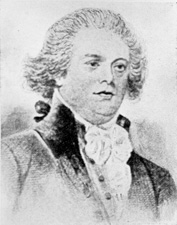John Laurance
| John Laurance | |
|---|---|
 |
|
|
United States Senator from New York |
|
|
In office November 9, 1796 – August 1800 |
|
| Preceded by | Rufus King |
| Succeeded by | John Armstrong, Jr. |
| Judge of the United States District Court for the District of New York | |
|
In office May 6, 1794 – November 8, 1796 |
|
| Appointed by | George Washington |
| Preceded by | James Duane |
| Succeeded by | Robert Troup |
| Member of the U.S. House of Representatives from New York's 2nd district |
|
|
In office March 4, 1789 – March 3, 1793 |
|
| Preceded by | District created |
| Succeeded by | John Watts |
| Personal details | |
| Born | 1750 Falmouth, Cornwall, England |
| Died | November 11, 1810 (aged 59–60) New York City, New York |
| Political party | Federalist |
John Laurance (1750 – November 11, 1810) was an American lawyer and politician from New York.
He emigrated to the United States in 1767 and settled in New York City where he read law and entered private practice in 1772. At the outbreak of the American Revolutionary War, he was a warm adherent of the revolutionaries. He received an officer's commission in the First New York regiment of the Continental Army in 1775, serving under his father-in-law Gen. Alexander MacDougall. He was Judge Advocate General from 1777 to 1782. He was a member of the board that convicted Maj. John André of spying and sentenced André to be executed by hanging.
He was a member from Westchester County of the New York State Assembly in 1782–83, and from New York County in 1784-85. He was a delegate to the Continental Congress from 1785 to 1787. He was an ardent supporter of the constitution proposed by the Federalists, and lost his seat in 1788 to an anti-Federalist. He was a member of the New York State Senate (Southern District) from 1788 to 1790, but vacated his seat after the Legislature enacted in January 1790 a law that made it impossible to be a member of Congress and the State Legislature at the same time.
In March 1789, Laurance was elected as a Federalist to the 1st United States Congress, and re-elected in April 1790 to the 2nd United States Congress, serving from 1789 to March 4, 1793.
...
Wikipedia
